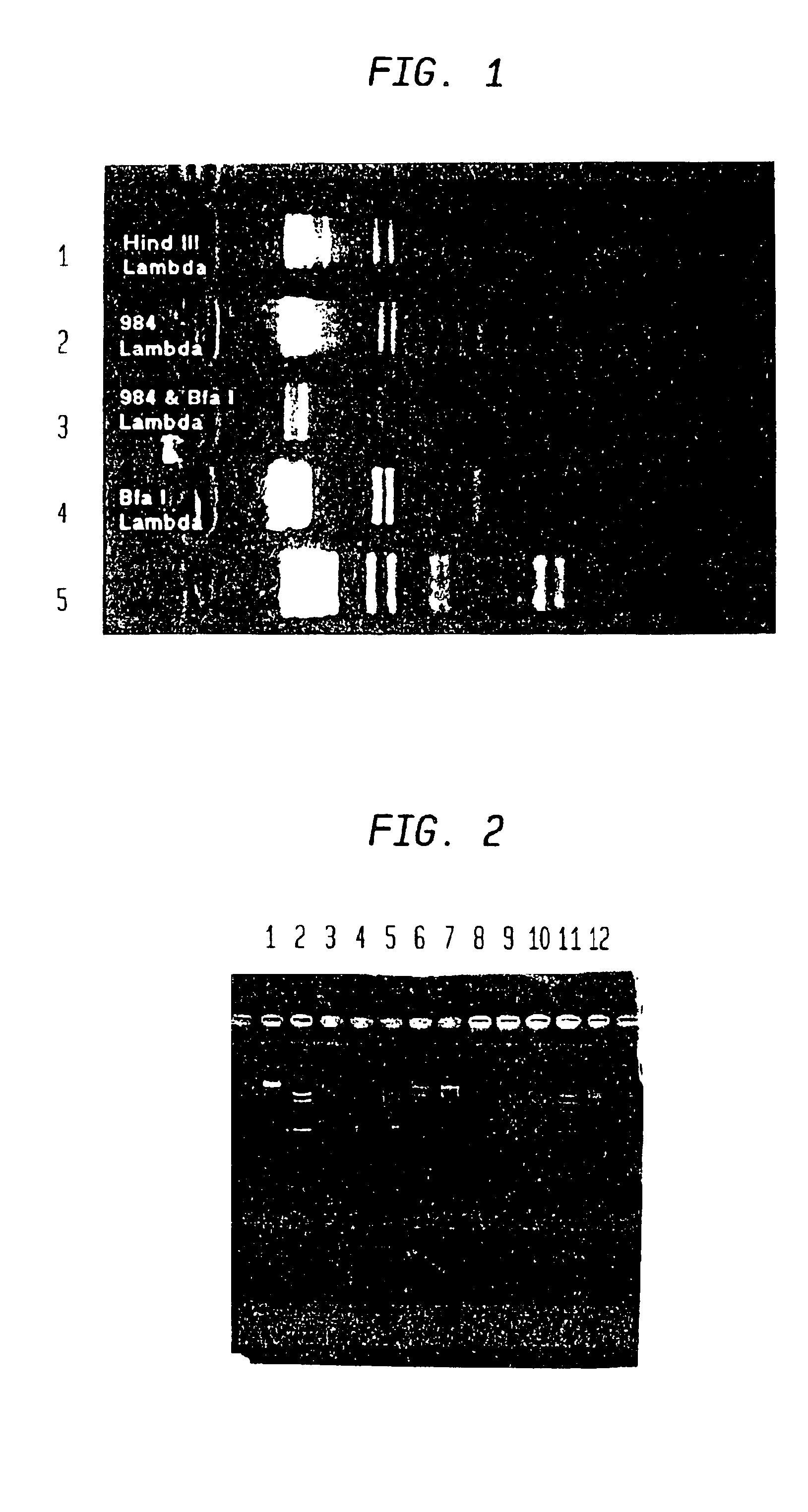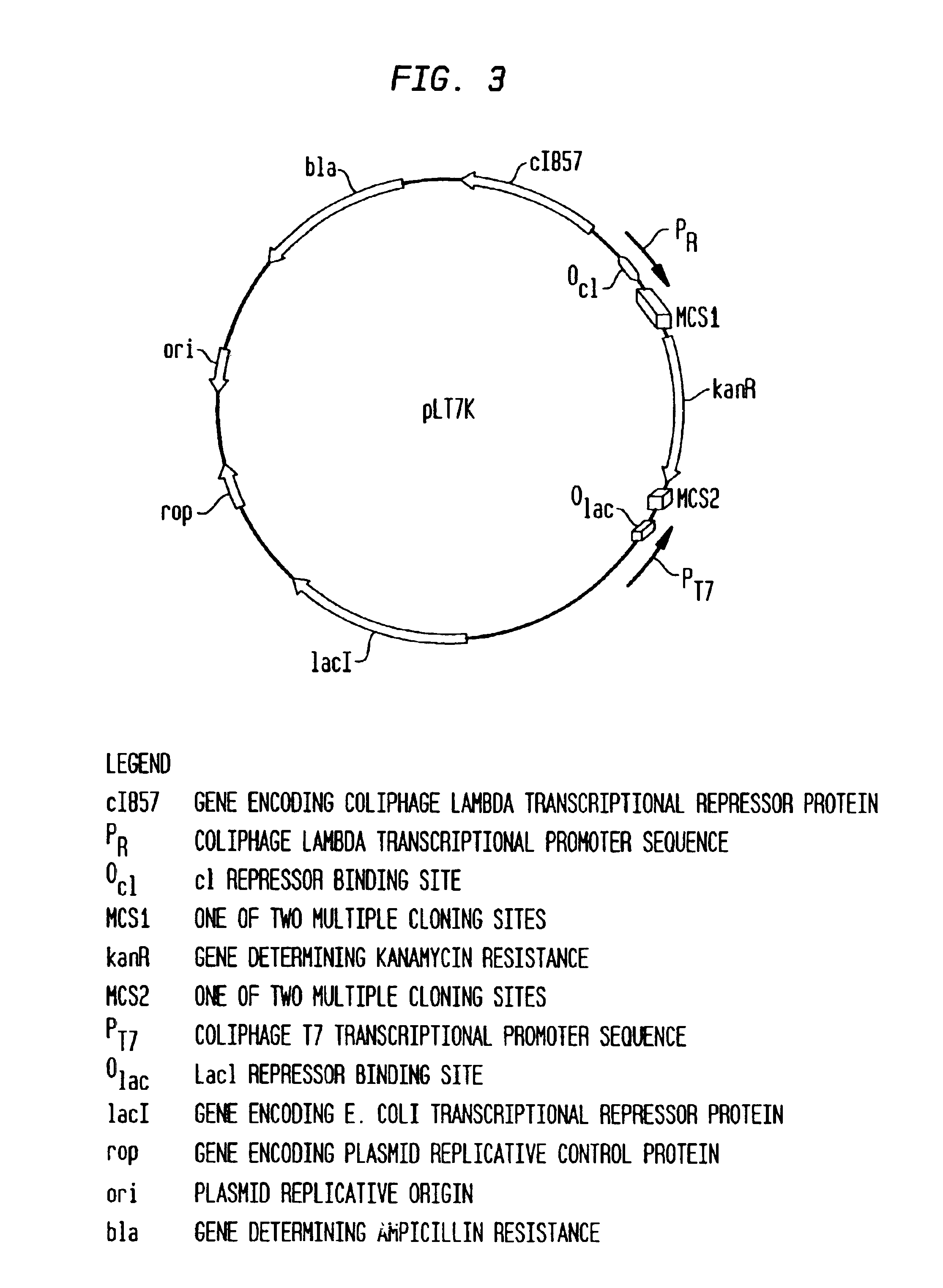Method for screening restriction endonucleases
a technology of restriction endonucleases and endonucleases, which is applied in the field of screening and identifying restriction endonucleases, can solve the problems of complex type i systems, failure to select, and dna susceptible to further degradation by non-specific endonucleases, and achieve the effect of facilitating characterization, cloning and production
- Summary
- Abstract
- Description
- Claims
- Application Information
AI Technical Summary
Benefits of technology
Problems solved by technology
Method used
Image
Examples
example i
MjaI Restriction Endonuclease
[0078]The restriction endonuclease MjaI, from Methanococcus jannaschii, has previously been characterized biochemically and shown to recognize the sequence CTAG (Zerler, B., Myers, P. A., Escalante, H. and Roberts, R. J. cited in REBASE—see Roberts, R. J. and Macelis, D. Nucl. Acids Res. 26: 338-350 (1998)), but the gene had not been cloned. With the recent determination of the complete sequence of the M. jannaschii genome (Bult et al. Science 273: 1058-1073 (1996)) the sequence was searched using the BLAST program (Altschul, et al. J. Mol. Biol. 215: 403-410 (1990)) to identify candidate restriction enzyme and methylase genes. In brief, all open reading frames in the sequence were compared with the RM sequence database that contained the published sequences of all DNA methylases and restriction endonucleases that had been compiled from entries in GenBank. Each match against an entry in this database was recorded and the corresponding region of the M. ja...
example ii
HhaI Restriction Endonuclease
[0089]The genes encoding the restriction endonuclease and methylase of the HhaI system have previously been cloned and sequenced (U.S. Pat. No. 4,999,293). Examination of the sequence showed a characteristic 5-methyl cytosine gene followed by an open reading frame on the complementary strand that was known to be the Hhal restriction endonuclease. This system was used as a test to show that it would be possible to make a sufficient quantity of the restriction enzyme in vitro to allow its detection using standard procedures.
[0090]First, plasmid DNA encoding the Hhal restriction system was prepared from E. coli NEB691 (New England Biolabs). The E. coli cells containing the recombinant plasmid were incubated in 10 ml LB in a roller at 37° C. overnight. Cells were pelleted at 4,000 rpm for 30 sec at 4° C. and the supernatant was discarded. The pellet was resuspended in 1 ml 1×GTE (50 mM glucose, 25 mM Tris.HCl, 10 mM EDTA, pH 8.0) and lysed by adding 0.2 M Na...
example iii
A 2nd Putative New Restriction Endonuclease from M. jannaschii (ORF 1328—GTNNAC, MjaIV)
[0095]Another of the open reading frames that showed a good match to a known methylase gene was MJ1328. This gene is similar to the gene for M.HincII, which recognizes the sequence GTYRAC. The open reading frame immediately preceding MJ1328 shows some low similarity to the gene for the HincII restriction enzyme and so is a good candidate for a new restriction enzyme of the same or related specificity. This open reading frame, MJ1327, comprises residues 1748-2485 of GenBank entry U67573. However, because M. jannaschii is a thermophile that normally grows at high temperatures, this new putative restriction enzyme encoded by the open reading frame MJ1327 may be anticipated to work at much higher temperatures than HincII, isolated from the mesophile Haemophilus influenzae serotype c (Landy et al. Biochemistry 13: 449-456, 1974).
[0096]The ORF designated MJ1328 by TIGR (The Institute for Genomic Researc...
PUM
| Property | Measurement | Unit |
|---|---|---|
| Cytotoxicity | aaaaa | aaaaa |
| Thermal stability | aaaaa | aaaaa |
| Physical properties | aaaaa | aaaaa |
Abstract
Description
Claims
Application Information
 Login to View More
Login to View More - R&D
- Intellectual Property
- Life Sciences
- Materials
- Tech Scout
- Unparalleled Data Quality
- Higher Quality Content
- 60% Fewer Hallucinations
Browse by: Latest US Patents, China's latest patents, Technical Efficacy Thesaurus, Application Domain, Technology Topic, Popular Technical Reports.
© 2025 PatSnap. All rights reserved.Legal|Privacy policy|Modern Slavery Act Transparency Statement|Sitemap|About US| Contact US: help@patsnap.com


